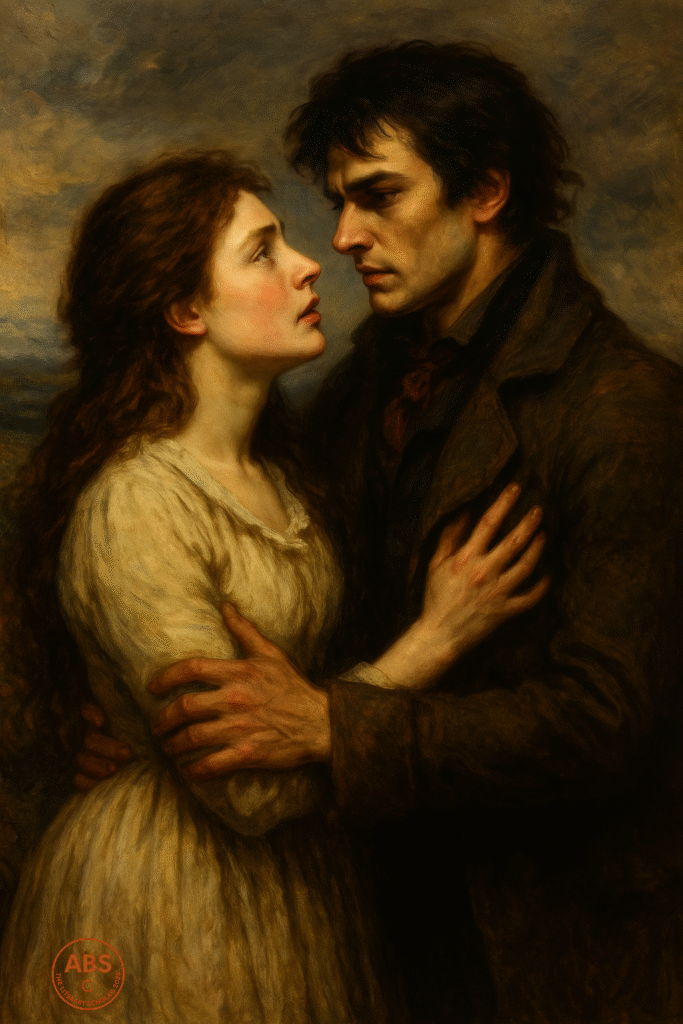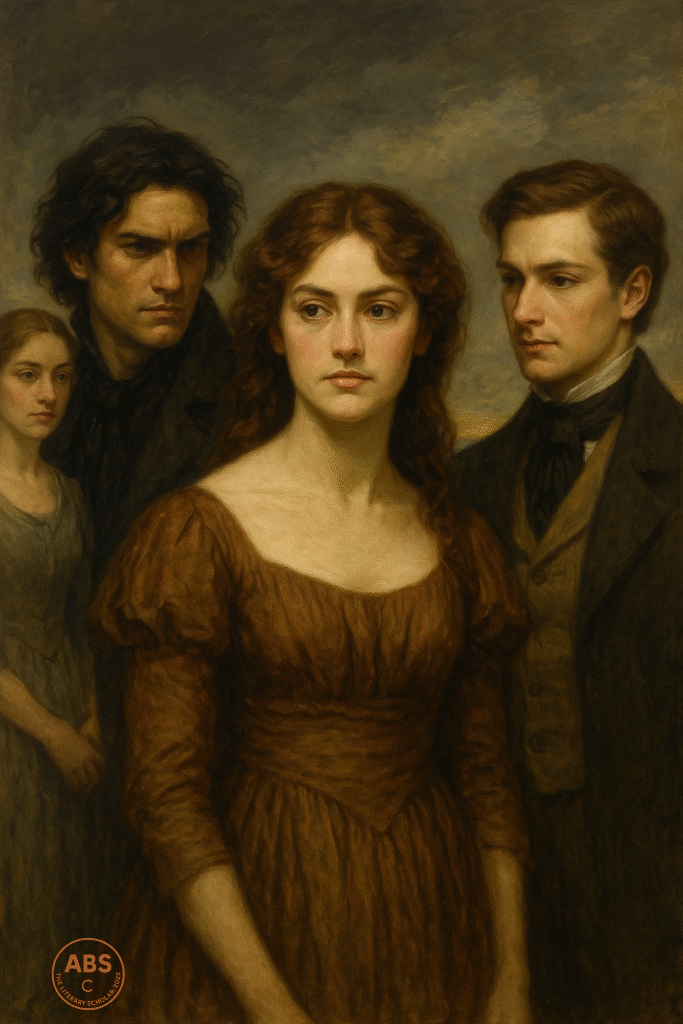By ABS, The Literary Scholar
(Who firmly believes therapy might’ve saved the Yorkshire moors a lot of emotional storm damage)
Some love stories bloom in gardens. Others burn in bonfires. And then there’s Wuthering Heights—a romance so fierce it cracks windows, howls through chimneys, and demands to be resurrected at midnight with a blood oath and a broken heart.
Written by Emily Brontë, the quietest of the Brontë sisters and a literary one-hit wonder of mythical proportions, Wuthering Heights is not your average Victorian love tale. There’s no armchair courtship, no laced-up propriety. Just raw, reckless passion—the kind that doesn’t knock politely but kicks down doors and refuses to leave.
Emily Brontë: The Phantom Novelist
Before we step into the whirlwind that is Heathcliff and Catherine, let us take a moment for Emily. The middle Brontë. The reclusive genius. The woman who wrote only one novel and casually changed English literature with it.
She published Wuthering Heights under the masculine pseudonym Ellis Bell (because patriarchy, of course), and critics at the time called it “coarse,” “brutal,” and “morally repellent.” In other words, she was doing something right.
Little did they know this wild, storm-breeding novel would outlive them all.
Enter the Heights: A House Where Passion Pays Rent
The setting itself is a character. Wuthering Heights isn’t just a house—it’s a metaphor wrapped in a weather report. With its crumbling stones and slamming doors, it mirrors the hearts that beat too loudly within its walls.
And at the centre of the storm: Catherine Earnshaw and Heathcliff—two people who are not in love as much as possessed by each other.
Catherine is not your Austenian heroine. She’s impulsive, unruly, and as emotionally stable as a thundercloud. Heathcliff, her adopted companion, is a smoldering mystery: orphaned, dark-skinned (hinted), and brooding enough to suck all the sunlight out of Yorkshire.
Their connection is instant. Primal. Unspoken.
“Whatever our souls are made of, his and mine are the same.”
It’s not “I love him.” It’s “We are made of the same existential starstuff and will haunt each other through every dimension.” Romantic? Yes. Healthy? Not even slightly.
Love Me or Else: The Catherine Paradox
Catherine is a psychological paradox wrapped in petticoats. She loves Heathcliff—madly, metaphysically, mad-scientist levels of love—but she marries Edgar Linton, the safe, polished, “civilized” gentleman next door.
Why?
Because Catherine Earnshaw, goddess of emotional chaos, wants the best of both weather systems: the storm and the sun. Heathcliff is her soul, but Edgar is social capital.
She says—brace yourself—
“It would degrade me to marry Heathcliff now; so he shall never know how I love him… Nelly, I am Heathcliff!”
Congratulations, Cathy. You’ve just committed the most poetic form of emotional sabotage in literature.
Heathcliff: Man, Myth, Walking Red Flag
Heathcliff takes this betrayal not so much to heart as to eternity. He disappears for three years, presumably lifting emotional weights and learning to weaponize wealth.
He returns transformed: rich, brooding 2.0, and fully prepared to make everyone pay.
To make Catherine jealous (and possibly just for the sheer Shakespearean spite of it all), he seduces—and marries—Isabella Linton, Edgar’s sister. It’s not love. It’s vengeance with a wedding ring.
“She abandoned them under a delusion,” he later says of Isabella.
“Picturing in me a hero of romance, and expecting unlimited indulgences from my chivalrous devotion.”
Spoiler: chivalry left the building at Wuthering Heights somewhere around page two.
Catherine’s Meltdown and Exit Stage Tragic
The moment Catherine realizes Heathcliff is slipping through her grasp, she does what any emotionally unregulated romantic heroine might do—she starves herself, rants at walls, and generally dissolves into a gothic puddle of poetic suffering.
Her death is pure melodrama.
“I wish I were a girl again, half savage and hardy, and free.”
She dies giving birth to Cathy II (because this story clearly needed more layers of confusion), and Heathcliff, who hears of her passing, doesn’t weep—he howls at the universe.
“I cannot live without my soul!”
Reader, same. But also, get some therapy.
Post-Catherine: Ghosts, Graves, and Generational Trauma
The second half of Wuthering Heights is like a sequel nobody ordered, where Heathcliff becomes a full-time landlord of doom and rents out emotional suffering like it’s a side hustle. He raises Cathy II, Hareton (Hindley’s neglected son), and his own son Linton in a blend of punishment and petulance.
But slowly, very slowly, love starts to sneak back in.
Cathy II and Hareton fall in love. Redemption tiptoes through the ruins. And on one dark night, Heathcliff—older, more ghost than man—begins to see Catherine everywhere. In faces, in windows, in dreams.
And then, at last, he dies. Peacefully. Which is frankly shocking.
“I have to remind myself to breathe—almost to remind my heart to beat!”
It’s the gentlest line from a man who once emotionally bulldozed an entire household.
So What Was This? A Love Story or a Psychological Thriller?
Wuthering Heights is the original toxic situationship, soaked in poetry and wrapped in grave dirt.
Catherine and Heathcliff don’t fall in love. They fall into each other like fire into wind. They don’t complement each other; they combust. Their love is less about compatibility and more about collision. And yet… it’s unforgettable.
Why? Because Emily Brontë doesn’t write lovers—she writes forces of nature. These aren’t characters. They’re elements. Catherine is air and storm. Heathcliff is earth and fire. Put them together, and the weather turns literary.
Final Thoughts from the Heights
Emily Brontë never wrote another novel. She died young, her wild heart unrecognised in her own time. But in one book, she gave us a love that refuses to stay in its coffin.
A story where the passion is volcanic, the pain poetic, and the setting a breathing beast.
In a world of happy endings, Wuthering Heights is a snarling exception. It doesn’t ask for approval. It doesn’t end with kisses—it ends with graves and ghost sightings and the question:
Can love survive death, madness, and the moors?
Emily’s answer? Only if it’s the kind of love that ruins absolutely everything.
ABS, The Literary Scholar:
(Steps away from the moors, hair windblown and heart slightly scorched, picks up the torn diary pages of Catherine’s ghost and presses them between the covers of a forgotten Brontë edition. Lights a candle, then blows it out—because some love stories are better left in the dark.)


Who knows love should never be this destructive—unless it’s literary.
Still listening for Catherine’s knock on the window on stormy nights
And wondering what Yorkshire tea tastes like with a side of poetic trauma.
Signed:
ABS
The Literary Scholar
Share this post / Spread the witty word / Let the echo wander / Bookmark the brilliance
